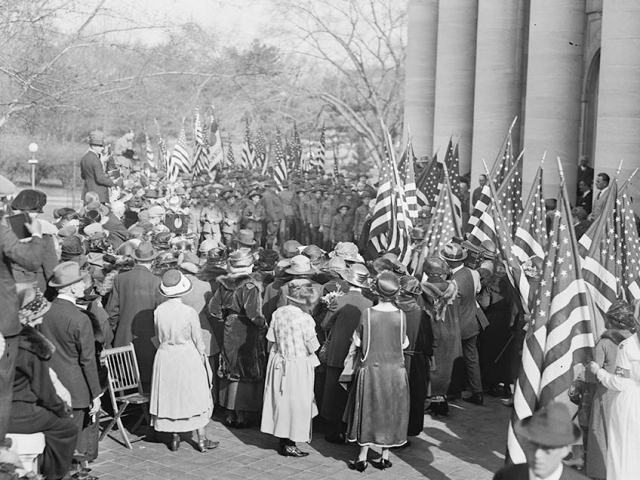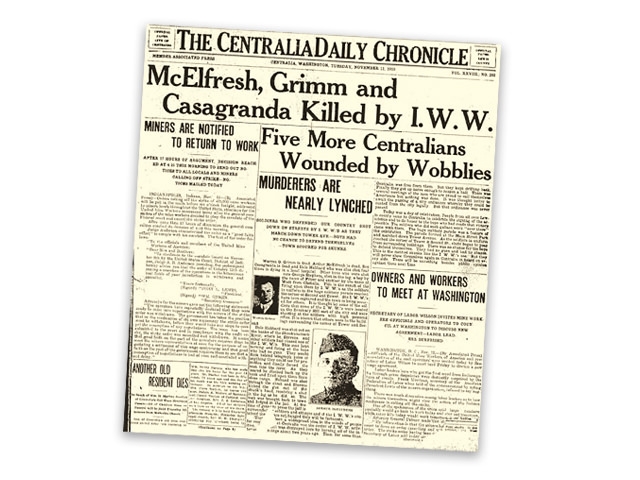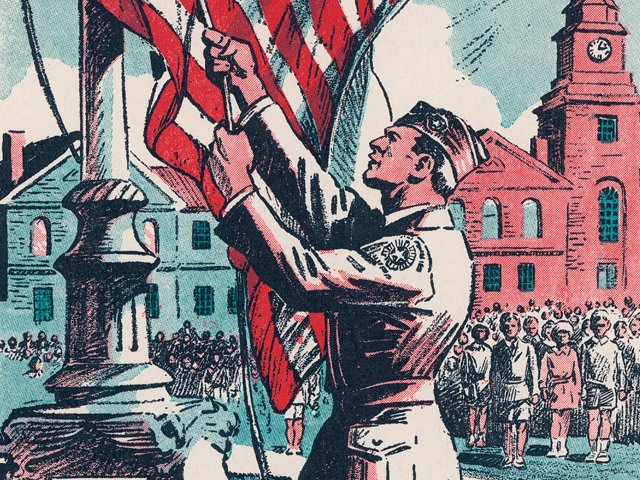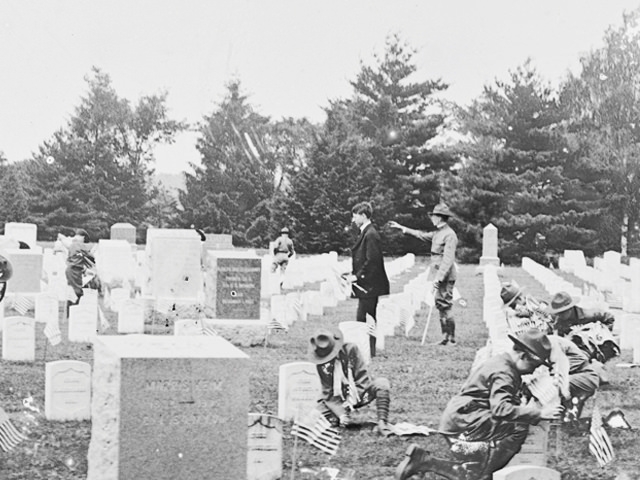Americanism
Americanism
100 Percent Americanism
First National Convention
In his message summarizing the “high spots” of The American Legion’s first national convention, National Adjutant Lemuel Bolles references the killings of four Legionnaires and a deputy sheriff in Centralia, Wash., during an Armistice Day parade on Nov. 11, 1919. Blamed and convicted are members of the International Workers of the World – the “wobblies” – who advocate international unionization and socialism and are viewed as anarchists who threaten American democracy. Retaliation to the shootings in Centralia were “illustrations of 100% Americanism,” Bolles writes. As foreign immigrants pour into the United States and allied territories like Hawaii and the Philippines in the early part of the 20th century, communities often assume the national identities they left behind rather than adopt American culture. The early American Legion feels compelled to stand as ambassadors of U.S. national identity, unity, legal citizenship and naturalization. And they are steadfast opponents of ideologies that threaten U.S. democracy, having known what it was like to serve in Europe alongside troops who did not necessarily understand exactly what they were fighting for.
The First Americanism Resolutions
The first national convention passes a resolution to form “a commission of The American Legion to foster and perpetuate a 100% Americanism.” Its mission would be to combat anti-American activities and propaganda (which were on the rise in America in the post-Bolshevik Revolution era); educate immigrants, prospective U.S. citizens and alien residents in the principles of Americanism; inculcate the ideals of Americanism to the citizen population in order to prevent special interest or class divisions across the country; spread to the U.S. public the “real nature and principles of American government”; and “foster the teaching of Americanism in all schools.” The resolution – which called on the Legion to speak up forcefully against “Bolshevism, IWWism, radicalism and all other anti-Americanisms” – urged Legion post members to be “a constructive force for the upbuilding of a vital knowledge of the principles of the Constitution of the United States and the process of law and order … under that Constitution.” The first Americanism resolutions call on the Legion to “secure… a love and respect of flag and country” and for all public schools to commit no less than 10 minutes per day to patriotic exercises. Other resolutions under the 100% Americanism umbrella deal with repercussions for aliens who avoided wartime enlistment and dodged the draft because, though they lived in the United States, they had never obtained U.S. citizenship; deport aliens who had been convicted as “enemies of our government”; and “that all our schools be thrown open to aliens for night courses” to become naturalized citizens. On Jan. 19, 1920, the Americanism Committee appears before Congress to offer the organization’s services and facilities to help immigrants become citizens.
Support for Boy Scouts
The initial youth program supported by American Legion resolution comes during the first national convention.
RESOLVED: The American Legion heartily commends the principles and achievements of the Boy Scouts and recommends that each post assist the Scout troops in its community in whatever manner practicable.
Thus launched a relationship that would connect American Legion posts with scouting units across the decades. By the end of the Legion’s first century, more than 2,500 scouting units would be sponsored by posts. Legionnaires provide meeting places, share in flag-retirement ceremonies, serve as leaders, support Eagle Scout projects and offer scholarships, including the national $10,000 Eagle Scout of the Year award.
The Americanism Commission
The concept of 100% Americanism is a rallying cry for veterans of the Great War. On Sept. 29, 1920, the formal establishment of an Americanism Commission is passed on a crowded agenda at the second national convention. The commission is made responsible for fulfilling the same interests expressed in 1919, when it was formed as a committee, to provide education service for immigrants so they can become U.S. citizens, protect Hawaii from being overrun by Japanese immigrants with uncertain motives and to promote the “Americanization” of the U.S. territory; improve development and acceptance of American history and government in public schools and colleges; reduce illiteracy; promote voting; and assist American Legion departments in their Americanism programs.
Relationship with the National Education Association
The National Education Association, at its July 7, 1921, annual meeting in Des Moines, Iowa, accepts The American Legion’s offer “to cooperate with the NEA in securing for America a program of education adequate to meet the needs of the 20th century ... and which will make all, whether native or foreign-born, good American citizens.” At this time, only 15 million of the 27 million school-age children in America attend school daily. The Legion calls for no less than a high school diploma and two years of professional experience for teachers and urges that English be the primary language taught and that history and civics be added to curriculum. This relationship leads to the first American Education Week Dec. 4-10, 1921, to improve public schools, attendance and curriculum on U.S. history and citizenship.
American Legion Flag Conferences
“That piece of red, white and blue bunting means five thousand years of struggle upwards. It is the full-grown flower of ages of fighting for liberty. It is the century plant of human hope in bloom.”
- American Legion National Commander Alvin Owsley, 1923
President Warren G. Harding is the keynote speaker at an American Legion Americanism Commission-organized conference June 14, 1923, in Washington to establish rules of respect and procedure for the U.S. flag. The National Flag Conference brings together 68 organizations, including military service branches, educators and government officials. The event is coordinated by The American Legion’s Americanism Commission. One year later, on Flag Day 1924, the second American Legion-coordinated National Flag Conference ratifies rules of respect and treatment of the U.S. flag. Across the country, the code is quickly applied by states, schools and local government, but it takes 19 years before Congress passes U.S. Flag Code, in 1942.
American Legion Baseball is born
The idea of American Legion Baseball originates on July 17, 1925, in Millbank, S.D. Sioux Falls attorney and South Dakota American Legion Department Commander Frank G. McCormick invites Maj. John L. Griffith to speak at the department convention. At the time, Griffith is commissioner of the Western Conference (later the Big Ten). A veteran of the Great War, he speaks to his fellow Legionnaires about the importance of athletics in the development of youth. That leads to the establishment of the first American Legion Baseball teams that summer in South Dakota, although Milbank would not have its own team until later. The idea spreads quickly across the nation, and a resolution at the 1925 national convention in Omaha in October makes it a national program, set to begin in 1926. On Oct. 15, 1926, a team from Cook Post 321 in Yonkers, NY, defeats a team from Pocatello, Idaho, to win the first American Legion Baseball World Series, in Philadelphia. Cost of the program, however, leads to a one-year suspension, until funds from Major League Baseball are obtained to stand it up again the following year. The Depression would later force Major League Baseball to withdraw its funding, and a network of newspapers across the country covered the cost. Professional baseball resumed its financial support in 1935. By the 100th anniversary of The American Legion, the baseball program started by veterans would send no fewer than 77 players to the Pro Baseball Hall of Fame in Cooperstown. In 2009, the American Legion World Series would be streamed online for the first time. By 2017, the entire tournament would be aired and streamed by EPSN.
School Awards Program
Originating five years earlier in Pennsylvania posts, the American Legion School Award program becomes national on Nov. 9, 1926, recognizing outstanding eighth-grade boys evaluated on five points: honor, courage, scholarship, leadership and service. The American Legion Auxiliary offers a similar award for girls on the basis of courage, character, service, companionship and scholarship. In its first year, 1,046 medals are awarded throughout the country. By 1943, the number would soar to 13,302.
American Legion Boys State
Legionnaires Harold Card and Hayes Kennedy organize the first American Legion Boys State June 23, 1935, at the Illinois State Fairgrounds in Springfield. Meant to counter the Soviet Union's communist Young Pioneer camps, Boys State quickly catches on as a nationwide program to teach young Americans their rights, privileges and responsibilities as franchised citizens, as they set up their own cities, counties and state governments and elect representatives. Each participant is instructed in the composition of government and the duties of public office.
At Issue with Isms
From the beginning, The American Legion has warned against radical ideologies that threaten the form of government veterans of the Great War fought to defend. Bolshevism, fascism and, in 1935, Nazism were among the “isms” The American rejected as such representatives of those ideologies were recruiting and promoting themselves in the United States. In 1937, The American Legion published a book simply titled “Isms” to explain the different ideologies and the threats they pose. Delegates at the Sept. 23-26, 1935, National Convention pass a resolution condemning a list of “isms” including the one in Germany that would soon propel the world back into war. In addition to ideologies, other isms opposed by The American Legion, by resolution or policy, included racism, sexism and anti-semitism.
The Oratorical Contest
On June 1, 1938, John Janson of Arizona wins the first American Legion National Oratorical Contest. The competition, which begins at the local post level and extends to districts and departments, not only assesses the quality of speaking among contestants, it also requires a thorough understanding of the U.S. Constitution. Competitors are judged on their ability to speak without notes on both a prepared oration regarding the Constitution and an assigned topic that comes from judges. Through the years, competitors and winners would include future Sen. Frank Church of Idaho, future U.S. Ambassador Alan Keyes of Texas, and future CNN co-founder Lou Dobbs. By its 80th year, the National Oratorical Contest would award more than $138,000 in annual scholarships to top competitors each year.
American Legion Boys Nation
Success of the Boys State programs throughout the country leads to a national version, which is initially called “The American Legion’s Boys Forum of National Government.” Legionnaire President Harry Truman greets the first class of boys on Aug. 9, 1946, on the final day of the event, conducted at American University. Three years later, in 1949, the program is renamed American Legion Boys Nation. In the years and decades to come, American Legion Boys Nation produces dozens of congressional representatives, governors, judges and one president, Bill Clinton, who famously met President John F. Kennedy while participating in the program on July 24, 1963.
Cold War and Communism
The American Legion’s firm opposition to communism and other ideologies that do not promote freedom and democracy is illustrated by a Jan. 28-29, 1950, “All-American Conference.” Sixty-six other organizations join the Legion movement to put up a unified front against communism, at the same time Soviet leader Joseph Stalin is jailing and executing critics of the government and as South Korea is invaded by North Korea, backed by communist China. The American Legion would vocally oppose communism through the 1950s and into the 1960s when American military troops are sent to Vietnam to fight further aggression by communist regimes. In 1961, World War II veteran and Havana American Legion Post 1 Commander Howard Anderson is executed by a firing squad after a show trial by the communist regime of Fidel Castro in Cuba. Among those assisted in the early effort to ward off communism in Vietnam are indigenous Montagnard people of the central highlands. The Montagnards are trained by U.S. Special Forces units prior to full U.S, entry in the war, and The American Legion would pass resolutions into the 21st century and support legislation to support their human rights and offer them safe and orderly departure as communist Vietnam nationalizes their lands, burns down their churches and seeks to remove them from the landscape.
The Bicentennial Freedom Bell
American Legion patriotism is on full parade for the 200th anniversary of the nation’s independence. In addition to hundreds of local activities, The American Legion assumes a place of honor on the artifact-filled “Freedom Train” that travels the United States over a 21-month period starting in April 1975. The Legion’s major contribution: an 8.5-ton copper replica of the Liberty Bell, tuned one octave lower than the actual Liberty Bell, to the key of F, for “freedom.” Approximately 7 million visit the 28-car train during its tour, and tens of millions more watch it pass along tracks throughout the country. The American Legion’s Freedom Bell is later given a permanent home on Columbia Circle outside Union Station in Washington, D.C.
To Protect the Flag
On June 21, 1989, the U.S. Supreme Court rules 5-4 in Texas v. Johnson that deliberate acts of U.S. flag desecration are protected under the First Amendment, a decision that triggers outrage from The American Legion and leads to a campaign for a constitutional amendment to return to states the power to protect the flag. In just 60 days, The American Legion collects more than 1 million signatures on a petition supporting a constitutional amendment to protect the flag. Congress passes a Flag Protection Act in October 1989, but the Supreme Court overturns it the following year. The American Legion forms a coalition of organizations in 1994 to help fight for the constitutional amendment. The Citizens Flag Alliance quickly grows to more than 140 groups. In every subsequent session of Congress, a bill is introduced to amend the Constitution to return to the states the right to protect the flag. The House is frequently above the needed 66 percent supermajority, but the Senate usually falls just short. On June 27, 2006, the Senate comes just one vote short. The tally is 66 for the flag amendment and 34 against. The Citizens Flag Alliance and The American Legion vow to continue fighting for the right to protect the flag.
Junior Shooting Sports
American Legion marksmanship programs were in place across the country, and a national committee oversaw them, in the earliest years of the organization, but it is not until 1991 that American Legion Junior Shooting Sports becomes a national program, promoting gun safety, marksmanship and competition. On June 15, 1991, Richard Wilson of Arizona and Everett Miskelly of Mississippi take home the titles from the first American Legion Junior Shooting Sports national championships, at the Olympic Training Center in Colorado Springs. Wilson scores a 2,201 to take the Sporter Division honors, and Miskelly fires a 2,335 to win the Precision title.
Youth Cadet Law Enforcement
Success in The American Legion’s Department of Nebraska, in particular, leads to national efforts to establish a youth program to stimulate interest, respect and understanding of law enforcement. Youth Law Cadet programs primarily operated locally and at the state level until a 1985 national convention resolution passed to study the feasibility of making it a national program. By 2011, the program begins to function at the national level, supporting model programs in multiple American Legion departments. A 2016 resolution gives the Youth Cadet Law Enforcement program an official name, committee and promotional support from national headquarters, for a program that aims to mentor young people to become good citizens and perhaps consider careers in law enforcement.
Scholarships
College scholarships for youth program participants, children of the fallen or disabled military personnel and others offer The American Legion additional ways to advance the Americanism cause of stimulating education. On July 28, 1995, electronics giant Samsung chose The American Legion to administer a scholarship fund of $5 million, as a gesture of appreciation for U.S. military personnel who came to South Korea’s aid to fight communist forces in the Korean War. The first 10 scholarships are awarded on Sept. 16, 1996, the anniversary of The American Legion’s federal charter approval. Seven to 10 scholarships of $20,000 each are awarded annually to high school juniors who complete either an American Legion Boys State or American Legion Auxiliary Girls State program and are direct descendants of U.S. wartime veterans. Applicants who are descendants of Korean War veterans receive special consideration. The American Legion Legacy Scholarship program provides college funds for the children of men and women who died on military duty or became 50 percent or greater disabled on or after the terrorist attacks of Sept. 11, 2001. More than $1.1 million in scholarships are awarded nationally, and another $4 million are presented in communities throughout the country and around the world.




